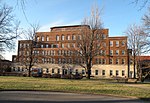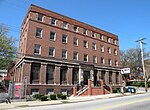Greenlee Field
Greenlee Field in Pittsburgh, Pennsylvania, United States, was one of few black-built and black-owned major league baseball field in the United States.The field was the dream of Gus Greenlee, owner of the Pittsburgh Crawfords. In 1931, construction started on Bedford Avenue between Chauncey and Duff in Pittsburgh's Hill District. The park opened on April 29, 1932, and reportedly cost $100,000. The first game was the next day, April 30, 1932, and had future hall of famers Satchel Paige pitching to catcher Josh Gibson as City Council members, the Allegheny County commissioners, and Mayor Kline watched from the stands. Greenlee Field held 7,500 spectators and it was the home field for the Crawfords throughout the Great Depression era. The Homestead Grays also played there for a time. Greenlee Field was located a few blocks up Bedford Avenue from Ammon Field, home to the Pittsburgh Keystones. Contemporary city directories list the ballpark's address as 2501 Bedford Avenue. Greenlee was forced to shut out blacks from ballpark jobs during the 1938 season. This angered the team's fans, and attendance lagged as a result. After the season, the Crawfords disbanded and Greenlee Field was torn down. The Bedford Dwellings housing project was later developed on the property. The Pittsburgh Steelers used the field for in-season practices during the 1930s.
Excerpt from the Wikipedia article Greenlee Field (License: CC BY-SA 3.0, Authors).Greenlee Field
Chauncey Drive, Pittsburgh
Geographical coordinates (GPS) Address Nearby Places Show on map
Geographical coordinates (GPS)
| Latitude | Longitude |
|---|---|
| N 40.4514 ° | E -79.9727 ° |
Address
Chauncey Drive 2566
15219 Pittsburgh
Pennsylvania, United States
Open on Google Maps






